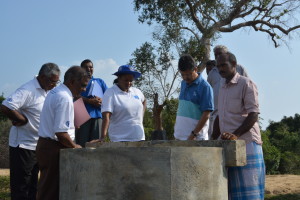Just three years ago the districts of Killinochchi and Mullaitivu in the North Western province of Sri Lanka were in a parlous state. Empty war- ravaged buildings gaped at passers-by in a lonely landscape scattered with headless palm trees. On either side of the rutted road, paddy fields had been abandoned and become choked with scrub. The districts were among those most affected by the country’s prolonged civil war. The coastal town of Mullaitivu was particularly hard hit by the twin onslaughts of the tsunami as well as civil war. Many households are now headed by women, having lost male members during the war.
But today the districts are thriving. Fields of vegetables, pulses and paddy abound, irrigated by the flowing waters of nearby tanks in which cattle and buffaloes wallow.

The transformation is in part due to a massive rehabilitation program that restored tanks and canals and helped build capacity. The Integrated Irrigation & Agricultural Livelihood Development project to the Kilinochchi and Mullaitivu districts, introduced by the Food and Agriculture Organization (FAO) and supported financially by the European Union (EU) is the cause of this transformation. The project took 35 months to complete at a cost of EUR 3,330,000 (about Rs. 550 million) and helped restore minor tanks and lands to about 170,000 people or 17,200 farming families.
A partnership to progress
FAO partnered with government organizations in the two districts. Ninety field officers were appointed to construct the irrigation infrastructure. Agricultural extension staff were trained in cultivation, water management and maintenance of the irrigation systems.
Minor irrigation systems, which include 436 minor tanks, occupy about 40% of farmland in the two districts. FAO restored 53 of these tanks using a selection criteria developed jointly with their government partners.

One example is the tank at Pookulum. The tank was abandoned during the war and breached during the 2008 monsoon rains. FAO and its partners rebuilt the tank bund and supply irrigation channels, and built a new sluice gate spill.
This allowed over 50 farmers in the area to plant about 160 acres of paddy, of which about two thirds was rain-fed and the balance irrigated from the tank. Agro and domestic wells were also recharged, and supply more than 100 families in the village. Over 2000 cattle and buffaloes drink from the tank and wallow in its waters.
Back to school

“Before the tank was rehabilitated our wells had salty water. Now we get fresh water even in this season of drought,” said Kandaiya Krishnapillai, President of the Thevipuram Farmer Organization. “We can also irrigate our home gardens using the water from the agro-wells. We had a very good paddy crop this Maha season. The spill water has been diverted into a pond in the jungle to cultivate 10 acres of banana. We cultivated groundnuts during the 2014 Yala season.”
The project also reclaimed about 2,600 ha. of abandoned land for irrigation, and introduced improved cropping varieties on about half of this. Farmers were encouraged to switch from high water-consuming crops and diversify into more water efficient and economically viable crops. These included ground-nut, chilies, green gram, black gram, cowpea, sesame, finger millet as well as improved paddy varieties.
FAO organized farmer field schools and crop clinics with the support of the Department of Agriculture, and provided fertilizer and agriculture tools. Agricultural extension officers trained 7,000 farmers in water management and improved farming techniques.
“Well-functioning tanks and rehabilitated lands are not only critical for agricultural activities, but lie at the heart of the livelihoods for these families, especially female-headed households, who have returned to their native places,” said Beth Crawford, FAO Representative for Sri Lanka and the Maldives.
The current year has brought some of the most challenging farming conditions in a generation. But the new emphasis on water security is paying dividends.
“I am 63 years old and this is the second worst drought that I have experienced in my life time,” says Krishnapillai. “If our tank had not been restored, we would have gone through untold hardships. I am comforted by the fact that my family has enough rice to eat until the next cultivation season arrives.”

